以2018國立臺灣文學館的「魔幻鯤島:妖鬼文學」展做為起點,接力打造一個團隊不同、方法論不同、觀點不同、場域不同、體驗不同的展覽,對於只有五年策展經驗的我,對於妖鬼文學一知半解的我,其實是一個冒險之舉。由於展覽所在的空總臺灣當代文化實驗場(C-LAB),本來就以「臺灣當代文化實驗」為任務,因此,這個展覽的構成,也必須小心回應這個尚待明確界定的、指向未來文化創作型態的任務。「妖氣都市」展覽開展一個多月以後,也是策展反思得以漸漸沉澱的時刻。
在《策展的挑戰:侯瀚如與奧布里斯特的通信》一書中,有一段話,引用了策展人瑪麗亞.林德(Maria Lind)編撰的《2015年歐洲文化政策》關於未來藝術創作與資金狀況的描述,特別打動我,也一直讓我謹記於心:
要由文學轉化為藝術策展,對我而言,首先就是要先跳出這些「藝術工具化」的思考格局,但與此同時,臺灣當代文化與歐洲當代文化的差別之處,在於臺灣的文化認同與身分問題,在這幾百年來,如同哲學家柄谷行人《帝國的結構:中心.周邊.亞周邊》中所言,早就位於帝國與殖民的亞周邊衝擊帶上,而「國家」與「國族」的構造,又長久受到帝國板塊的壓制而扭曲形變,甚至在當下國內選舉、美中貿易戰和香港反送中的問題推波助瀾下,這些板塊的擠壓更加劇烈,因此,從「臺灣」文學館轉換至「臺灣」當代文化實驗場的這個「妖氣都市」展,在「國家-國族-資本」的三位一體當下格局中,便顯得格外棘手。
有趣的是,在〈第九封信〉裡面,奧布里斯特也指出了「藝術與文學之間的橋梁,我覺得在我們這個時代強調得不夠。」(頁72)臺灣在去年的兩個大型雙年展「2018臺北雙年展」與「大臺北當代藝術雙年展」,不約而同地把小說家吳明益和駱以軍,放在整個展覽敘事的起點,把生態系統、科技系統、都市更新、歷史記憶與文學空間並置起來,這顯示先前的美術館劇場化、美術館表演場化浪潮,已進一步指向了「文學介入」當代藝術展覽場的趨勢。「妖氣都市」展要面對的第二個難題,便是如何在舊空總廢棄的空間中,打開「文學介入」當代藝術展覽的潛在可能。甚至我們可以說,在「妖氣都市」展的整個邏輯是反過來的,就命題而言,毋寧是「文學空間」先行在場,然後才是「當代藝術介入」,「妖氣都市展」要處理的策展命題,就文學與藝術的橋梁而言,與「2018臺北雙年展」和「大臺北當代藝術雙年展」而言是反向的:當代藝術要如何介入到當代妖鬼文學的文學場域之中?
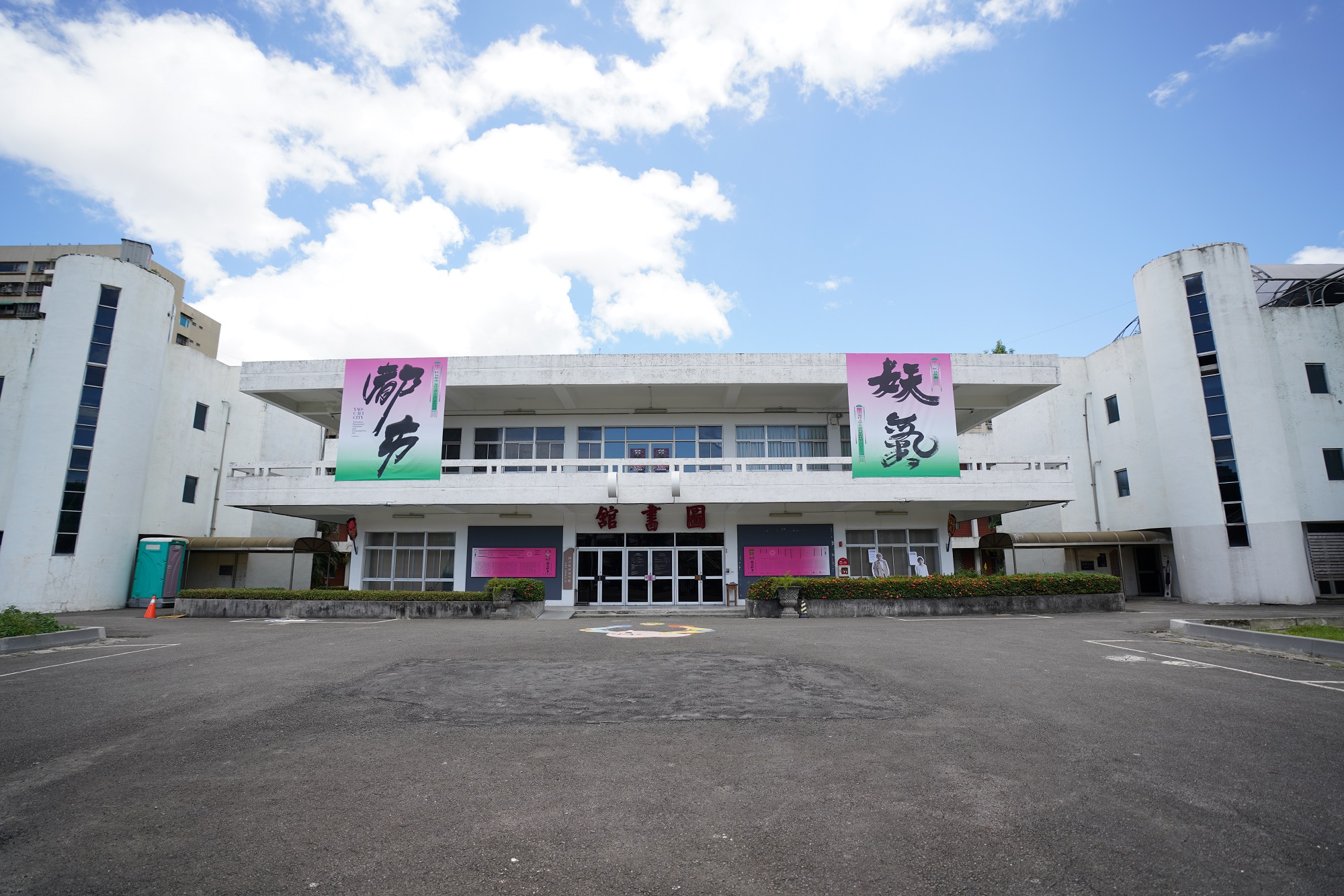 「妖氣都市:鬼怪文學與當代藝術特展」的主展場位於舊空總的圖書館展演空間。圖/周史賓攝影
「妖氣都市:鬼怪文學與當代藝術特展」的主展場位於舊空總的圖書館展演空間。圖/周史賓攝影
於是,在展覽籌備一開始的階段,確定了要以舊空總「圖書館」為主展場、要以臺灣當代妖鬼文學場為主要文學空間以後,來自臺灣文學館的策展人王嘉玲、臺北地方異聞工作室的策展人羅傳樵(瀟湘神)、花蓮「阿里嘎該――美崙山巨人和牠的產地」策展人黃啟瑞和代表C-LAB的我,在我的提議之下,就決定先建立一個共學空間:妖怪學院。妖怪學院當然首先是呼應奇幻文學空間傳統裡的霍格華茲學院、《地海巫師》系列中的巫師學院,或者是浮世繪畫師河鍋曉齋的妖怪學校,但同時也指向2007年臺東達仁鄉公所開辦多時的「女巫培訓班」。
妖怪學院的建立,就策展而言,即是組合妖鬼文學空間、巫術世界觀系統、當代藝術文化表現節點的一個生物湯和培養皿。換言之,將來在展覽的場域空總的「圖書館」向觀眾展開什麼樣的閱讀文本與閱讀模式,首先必須要有一個「準備中的圖書館」、「開放性的圖書館」,提供測試使用者的各種諮詢服務與查閱條目,策展團隊才能知曉,我們四個人在邀集各路作家與創作者來到小小的副執行長室「圖書館」討論的各種延伸網絡,在密室中持續五個月每周規律集會密集討論150個小時之餘,是否可能進行進一步的對話,而這些對話構造出來的「妖怪學院」共學平台,是否是一般市民所需要的知識條目。
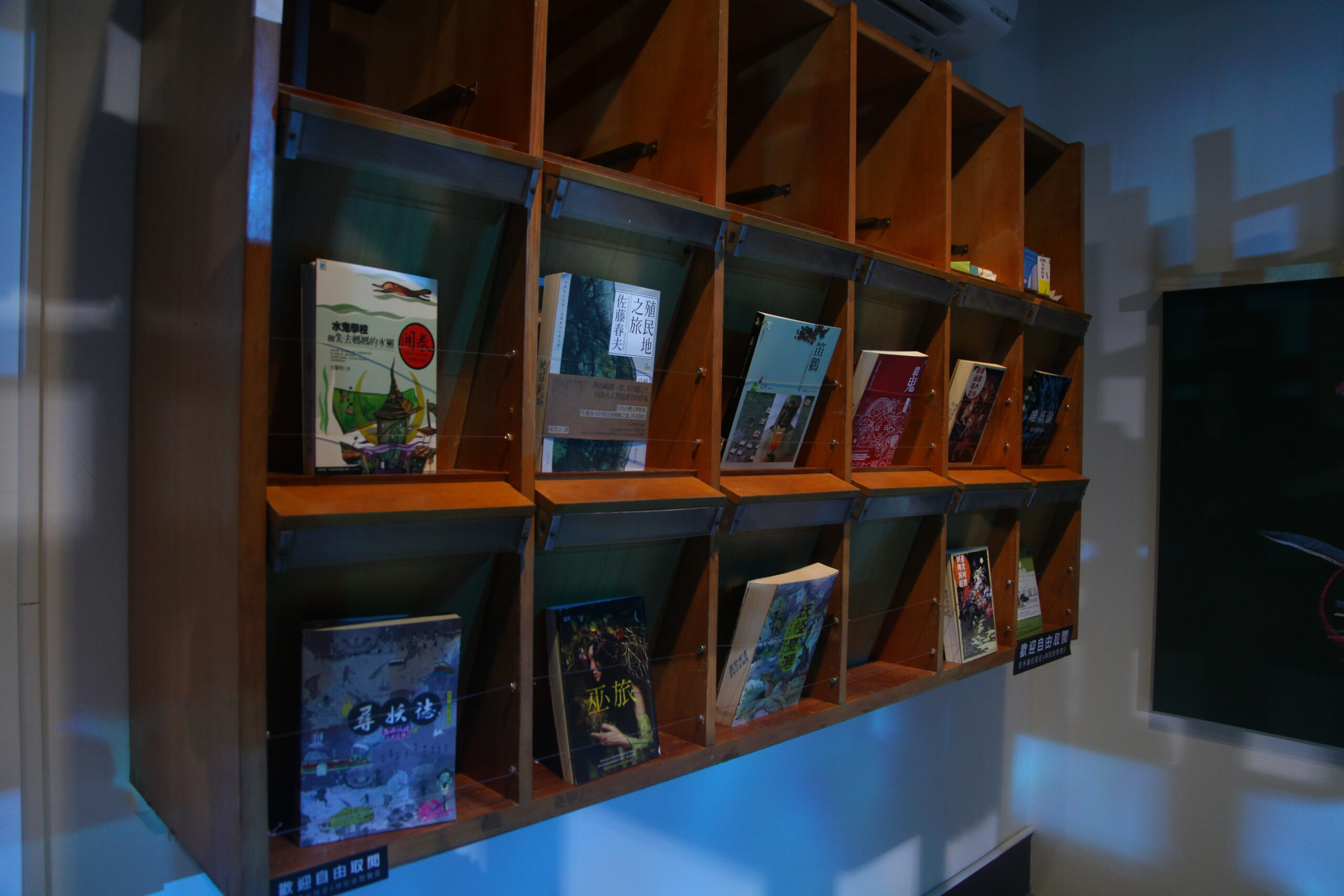 「妖氣都市」展覽的閱讀區有如一個小型圖書館。圖/陳政道攝影
「妖氣都市」展覽的閱讀區有如一個小型圖書館。圖/陳政道攝影
於是,從2019年2月16日開始,攝影家港千尋與瀟湘神談妖怪之隱、舞蹈家徐家輝談土方巽的幽靈之舞、民俗研究學者林承緯與蘇碩斌談民俗與當代社會、與小川直之談神樂、曲辰與東雅夫談怪談文學、楊雨樵談世界口傳文學中的妖、黃啟瑞與作家巴代談妖怪熱潮下的原住民處境、藝術家曾伯豪與戴開成的唸歌與落語演出、建築團隊談妖怪與空總場域,加上兩次的尋妖旅行(蟾蜍山與花蓮阿里嘎該)和涂維政的巨妖工作坊,「妖氣都市」展前半年超過13次的帶狀共學活動,實質上就是一次臺灣妖鬼的文化實驗,是一個讓「前圖書館」的幽靈重新活躍的實驗,同時,超過600人次的參與,也讓策展團隊了解到各方民眾參與的需求與必要。如果說這是為了建立一個「未來圖書館」的系列文化實驗行動,那麼這也可以說是重建臺灣妖鬼文化認識論基礎的「返田野」調查行動。
「返田野」涉及的是有別於古典單線田野的「碎形田野、二度田野與軟性田野」行動,強調它的「非生產性」與主體自省、邁向他者的「生命浸潤」過程。是的,什麼的「過程」,決定了什麼樣的「展覽」。有了「妖怪學院」提供的聲音、文學、藝術、民俗、當代社會、建築、旅行、原住民巫術系統的「返田野」對比認識基礎,接下來才是「妖氣都市」規劃中最為艱難的部分:如何選擇關鍵文學文本、如何展示這些關鍵文學文本?特別是在臺灣當代文學的閱讀人口,並不為大眾市場青睞的前提下,如何做出選擇?
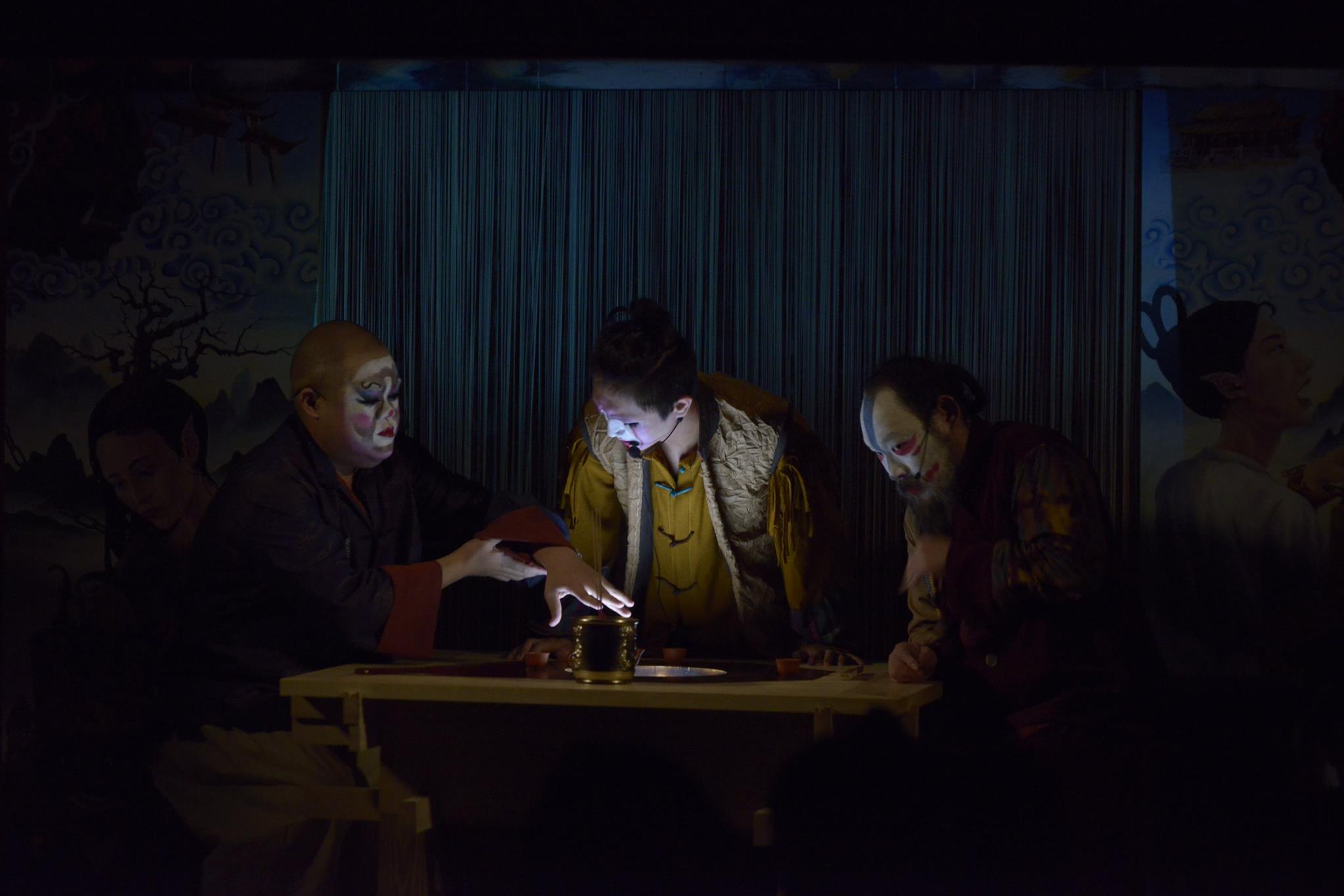 藝術家曾伯豪與戴開成在「妖氣都市」展的系列活動中帶來唸歌與落語演出。圖/妖氣都市展提供
藝術家曾伯豪與戴開成在「妖氣都市」展的系列活動中帶來唸歌與落語演出。圖/妖氣都市展提供
策展團隊剛開始的討論,焦點集中在小說家甘耀明的長篇小說《殺鬼》。對我而言,這本堪與《百年孤寂》對照的史詩級小說,從開篇的日殖火車大鐵獸、為抵擋鐵獸而變化為妖的小男孩「帕」、鬼王吳湯興,一直到拉娃所參照的白色恐怖原型丁窈窕,呈現了臺灣妖鬼在「身分之間的擺盪」,深深吸引我對妖鬼的思考。主角劉興帕的祖父曾參加抗日的乙未戰爭,帕自己則經歷皇民化運動而成為日本軍曹,戰後,又與祖父親證外省人與本省人的衝突。《殺鬼》中的妖與鬼,巧妙呈現了臺灣人身分認同上的劇烈震盪與無休止的危機,文學書寫技巧亦如萬花筒般高度瑰麗可觀。然而,就策展而言,我們要回到瑪麗亞.林德式的提問:這個展覽要把臺灣妖鬼的命題集中在「臺灣人的身分認同擺盪與危機」呈現嗎?
經過對原住民文化與植物學深研的黃啟瑞提醒,巴代的小說《巫旅》開始進入我們的討論視野。《巫旅》連接的不僅是世界奇幻文學的路徑,譬如《哈利波特》、《地海巫師》、《巫士唐望的世界》、高橋留美子的《犬夜叉》,讓卑南族大巴六九部落的女巫傳統和部落文史得以在小說中呈現,巴代在小說中,也讓大巴六九山坡稜線之後所延伸出的森林山川和生態當中的其他物種,檜木、樟樹、熊、山羊、山羌都出場發言,以千年樹精非人稱的視角,而不以人類為中心,展開「傳統領域之爭」的論辯。這個視角讓我大為驚訝,不僅讓我一下子把《聊齋誌異》蘭若寺中的樹精姥姥提升到大巴六九部落的具體地緣脈絡中,也讓我回憶起柳田國男在《妖怪談義》)中提到妖怪與具體場所之間的關聯。與此同時,若從當代「人類世」支離破碎的蓋亞觀點來看,《巫旅》當中的小女巫與小妖乙古勒視角,能夠帶領這個展覽進入的近未來世界觀,可以說是一種跳脫人類中心的、更為恢宏的觀點。
最近回頭尋找當初展覽規畫書的初稿,標明是在2018年的11月底,而具體內容規劃落定在《巫旅》這本小說的樹精與大巴六九山坡為起點的地理脈絡,已是2019年3月中旬了。這過程中,策展團體不知道經過了多少次的論辯,我們在巴代與甘耀明的文本之間徘徊。中間若說有什麼影響因素,或許是在3月初的時候,藝術家張恩滿引導我去臺東賓茂部落,在大武山保留區中,由東排灣黃俊明先生所帶領的部落溯源與獵人夜間訓練,特別是3月1日那一整夜五小時沿著金崙溪谷上游巡行部落獵場的激烈行程,對我有決定性的影響。那一整夜與兩天實地了解部落歷史與地理生態特徵的強度訓練,使我可以想像幾百年來原住民的遷徙路徑與生活方式的梗概。因此,雖然一直到2019年6月初,我才兩度走訪了巴代《巫旅》與其他小說中反覆書寫的大巴六九部落與利嘉林道山區,但是,我似乎已經可以聯想到《巫旅》中的山區地景,以及卑南族人和女巫們的生活氣息。
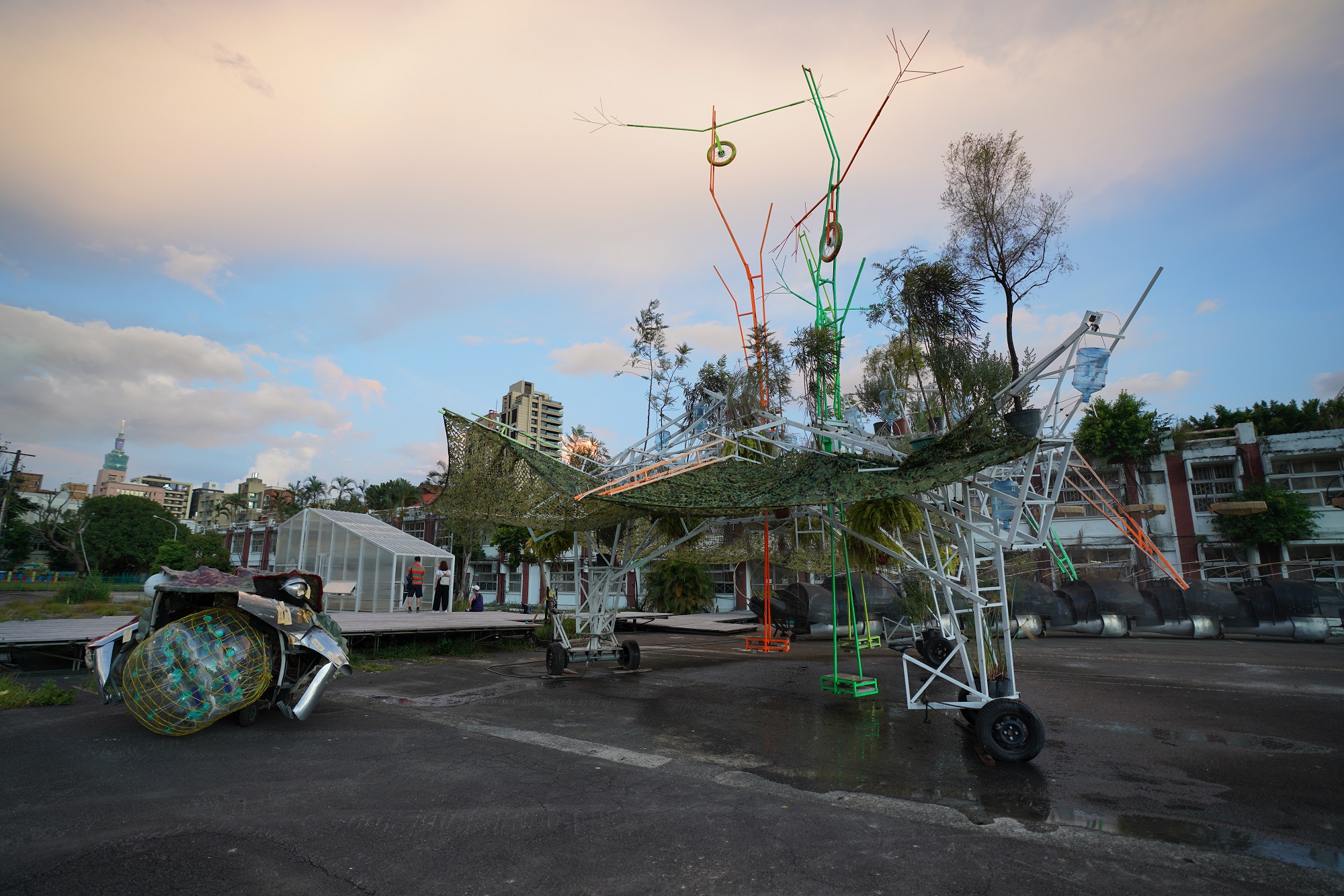 國立臺南藝術大學建築研究所B群創作的戶外裝置《樹妖》。圖/周史賓攝影
國立臺南藝術大學建築研究所B群創作的戶外裝置《樹妖》。圖/周史賓攝影
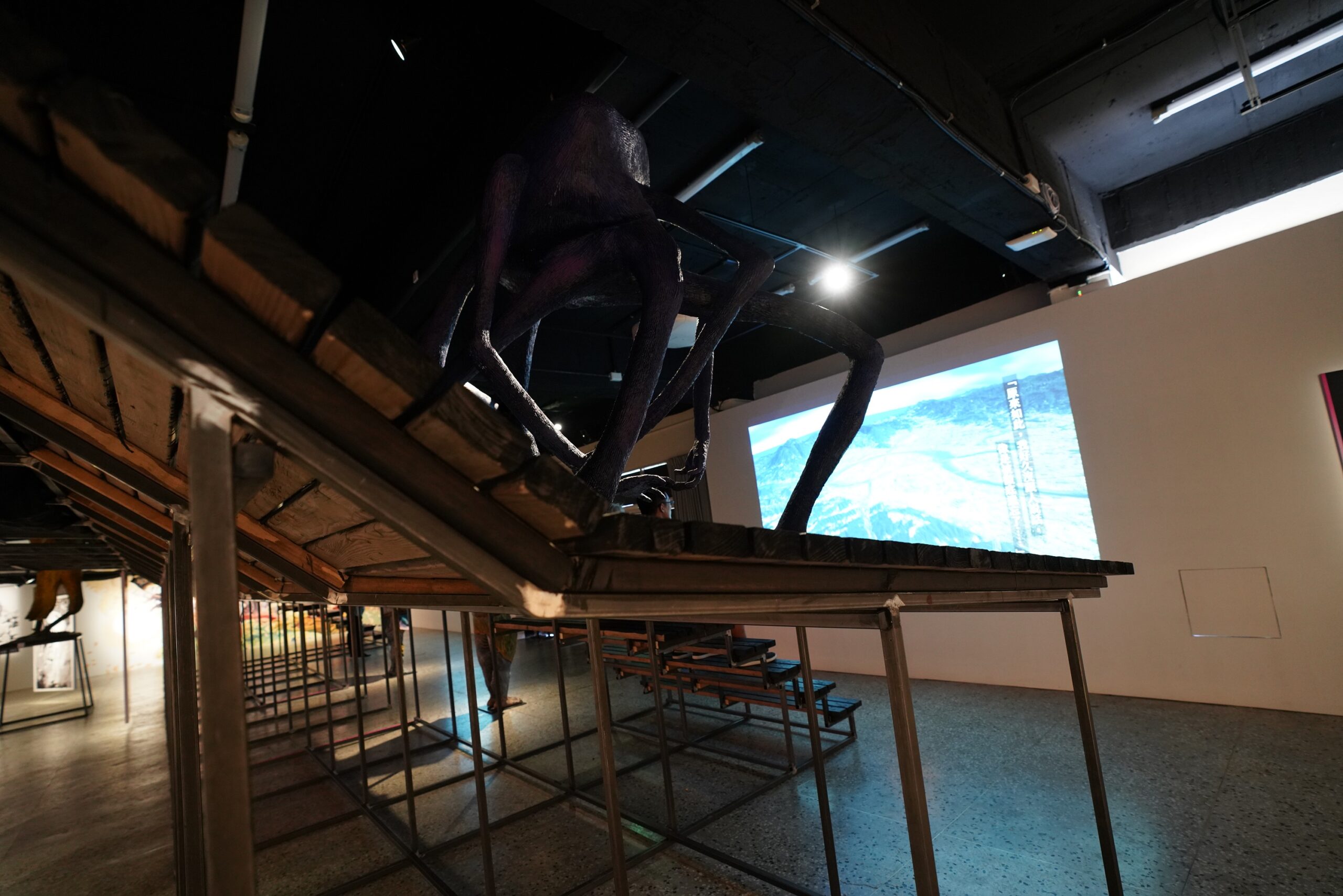 圖書館的展間經展覽團隊用斜坡結構體改造為大巴六九部落山區的擬態看台。雕塑作品為許自貴的《自畫像――藍色蜘蛛》(2000)。圖/周史賓攝影
圖書館的展間經展覽團隊用斜坡結構體改造為大巴六九部落山區的擬態看台。雕塑作品為許自貴的《自畫像――藍色蜘蛛》(2000)。圖/周史賓攝影
比較難得的是,建築團隊Group B與展場設計好輪團隊,很快就把圖書館一樓的展間,用一個橫越式的斜坡結構體,改造為大巴六九部落山區的擬態看台,同時也把看台下方與後方的區域,改變為平面視覺類的展場。在概念上,這就等於《巫旅》的立體書,是小說主場景山坡帶的展開。因此,「妖氣都市」展把當代妖鬼文學空間的閱讀,攤開在一座被廢棄的未來圖書館內外周遭,這樣的設計概念,就此成形。
有了這樣的主展場設計概念,羅傳樵提出了甘耀明《水鬼教室和失去媽媽的水獺》,做為一樓後半展場的主要概念,二樓前半原金國際王世偉的《妖市蜃樓》環形劇場與許自貴阿貴美術館的《大腳十二生肖》,後半部陳飛豪的《女誡扇綺譚》唸歌劇場,侯俊明與柘榴君的禁色空間,一樓外柏油廣場的巨大樹精遊行裝置,A棟軍官宿舍的《都市傳說冒險團》廢墟空間、考古計畫展示間,和A棟軍官宿舍前方草坪涂維政的《巨人與巨獸遺跡――義村遺址》,漸次成形,加上一樓後半水鬼教室和A棟軍官宿舍有兩個實體書的閱讀區,二樓前半有羊王創映《印象中的角落》中「妖怪醫院」的擴增實境閱讀區、原金國際的《妖怪森林外傳》漫畫影像閱讀區,等於是一本一本的妖鬼文學書在此未來圖書館中,以各種形式被打開翻頁,文學空間、圖書館空間、實體設計空間三個疊層交互滲入、彼此對話,使文學空間不致過度文字化,但又飽含訊息量,使實體空間不致過度抽象化,內蘊著文本的內涵。當兩者交會在「未來圖書館」的設計思考時,就是妖鬼文學成為體驗場域之時。
除了建築、視覺、AR、VR、遊戲、考古、遊行體驗的場域設計外,日本攝影家港千尋在一開始就強調了「聲音」之於妖鬼存在的重要性。他從小泉八雲書寫時對於以聲音來表現妖鬼存在氛圍的文學技巧出發,提到妖鬼存在的不確定性,「我之所以一直在這裡,是因為我不知道我在這裡的原因。」(巴代語)這種身分認同上的不確定性,可能因為不幸、因為意外、因為恥辱、因為剝削、因為階級的霸凌,而構成了妖鬼的暗黑式存在,接近台語說的「卡到陰」而不能脫身,找不到存在的理由。而這種存在氛圍,仍有其特殊的存在韻律。
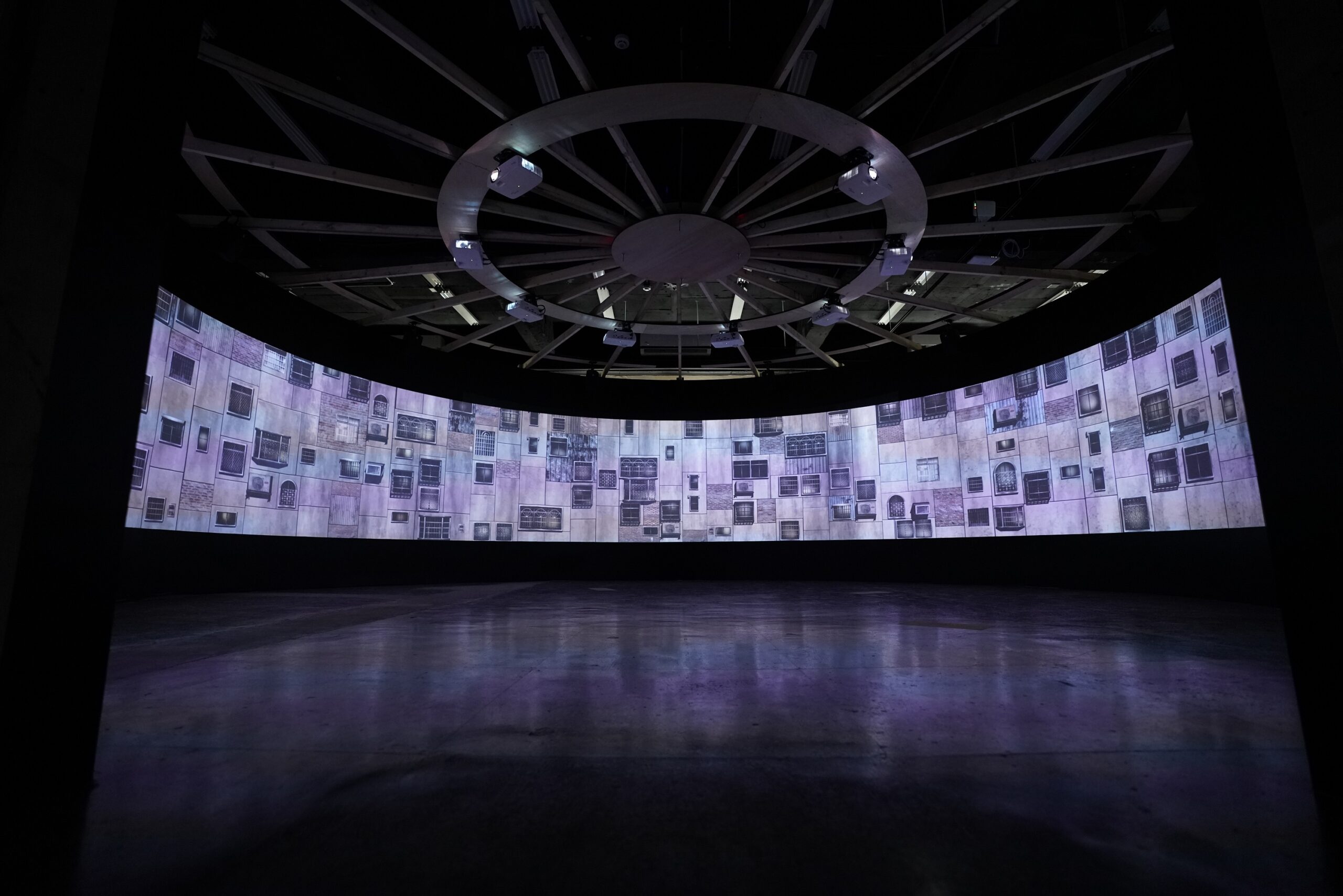 原金國際的《妖市蜃樓》環形劇場。圖/周史賓攝影
原金國際的《妖市蜃樓》環形劇場。圖/周史賓攝影
因此,我們邀請了數位音樂創作者李凌子,透過具象音樂的創作手法,蒐集了石塊移動、水滴、風吹、絲絃、落豆等等具體物件的聲樣,然後進行電腦編程的串接改寫,配合展場的整體氛圍的塑造,打開觀者的感官聲音共振場域,在視覺表現的強度之間取得一個新的平衡。李凌子的《巫聲》,同時與許自貴的六尊妖怪塑像、肯特動畫導演張永昌的《巫行》和諸多一樓前半展場的視覺藝術作品要產生共振,著實不易,但正因為有了這樣的聲音設計,許自貴自畫像式的內心欲求之妖《帶你去飛》與《藍色蜘蛛》,《巫行》影像中飛行的空氣震動拍掠,便在空氣中有了具體的拍打走跳痕跡。
行文至此,「妖氣都市」展做為文學與藝術的橋梁,究竟發揮了什麼樣的特異觀點,其實還得留待觀眾的體驗與評論者的意見來判斷。做為策展計畫的組織者之一的我,責任範圍仍然是做出最起碼的規畫說明與意向,做為感性判斷的可能依據之一。最誠實而核心的企圖,首先就是如何讓臺灣的「妖怪學」與日本的妖怪學做出明確的區分,盤點既有的妖鬼文學,轉化為藝術的體驗場域,以做為臺灣妖怪學未來與世界民間妖鬼文學對話的一種體驗呈現。然後,隨之而來的考驗,便是本文一開始所談論的避免策展將「藝術工具化」的命題,必須在展呈中取得形式考量上的優先性。關於這兩個核心命題,我想用兩個展呈的例子來說明,以便讓結論維持更高的開放性。
首先,如同前文所闡述的《巫行》這件影像作品,可以說是本展的開題之作。從製作的技術過程而言,《巫行》在國家實驗研究院國家高速網路與計算中心(國網中心)的協助共創下,透過衛星製作的臺灣地理3D數位模型的運用,展現的是妖鬼地理學的思維路徑。九組不同地理特徵與不同族群傳說的妖鬼形象,結合了插畫家張季雅的圖像,小說家巴代的《巫旅》文本,羅傳樵、王嘉玲的腳本改寫,李凌子的《巫聲》八聲道音景,最後是肯特動畫導演張永昌在大巴六九利嘉林道的實地拍攝,讓國網中心的算圖農場發揮高度效能,建築團隊的大巴六九斜坡展場結構成為看台,這七種不同創作界面的整合,加上現場許自貴的六組塑像,我想已超過了傳統所謂的「藝術創作」工作模式,若稱之為異質集體的「文化創作」,可能更為合適。這個文化創作的目的,就是要讓臺灣妖鬼展現嶄新的感性框架,超越原本民俗學的敘事,把臺灣地理學的訊息、個體內心的暗黑處所、妖鬼的移行聲景,匯整為新的第一人稱妖鬼凝視,由這個視線帶領觀者的體驗飛行、感受、探索、提問,從而對於「妖氣」的運行宇宙,產生由原住民巫覡傳統在近現代都市化之後蘊生出來的人類世宇宙觀。這樣的原住民巫覡宇宙觀,至今不僅並未完全消隱,更可能是未來臺灣妖怪學的特異文化資產,值得運用當代觀點加以活化。
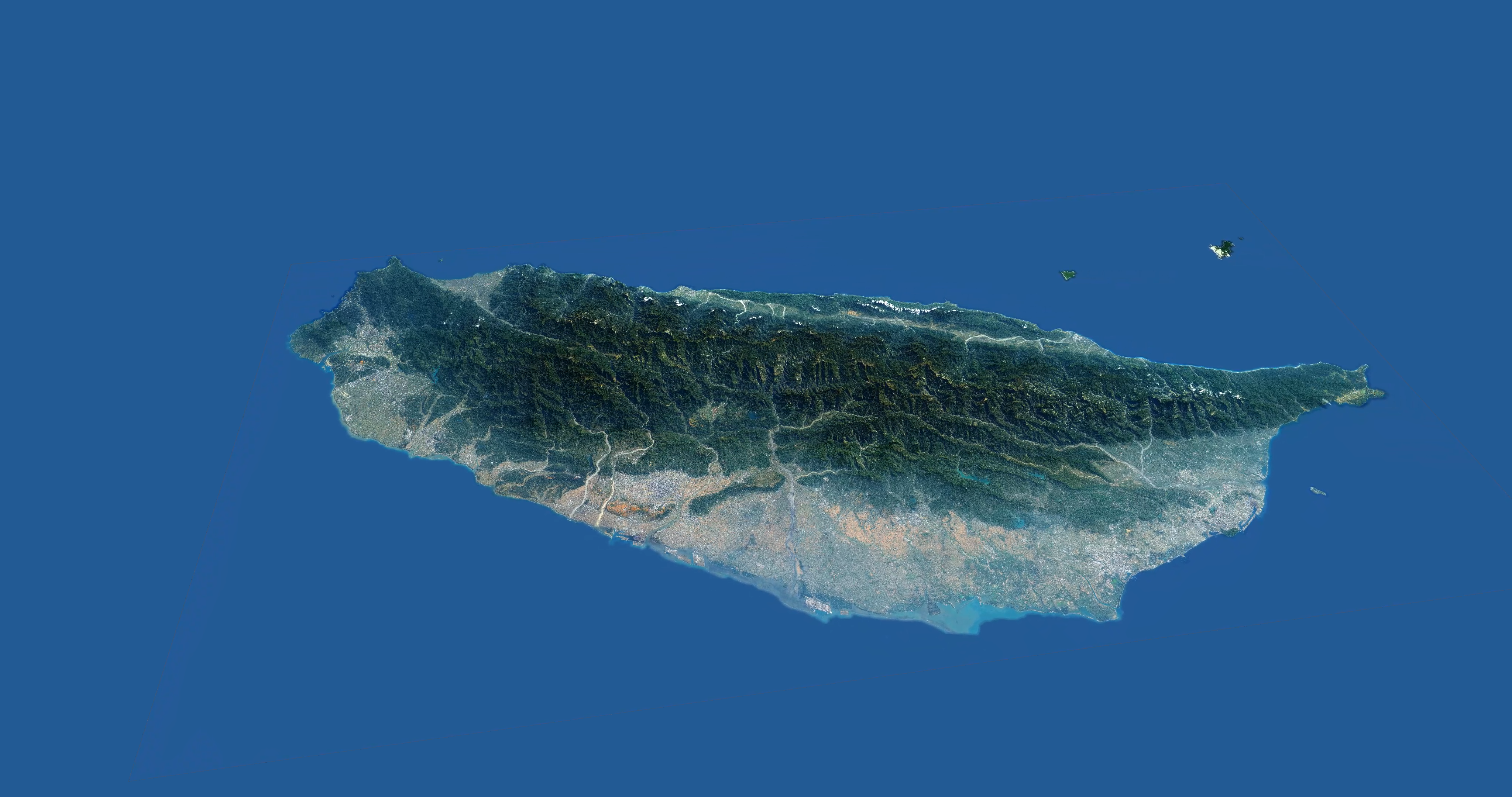 《巫行》是運用科技來探討臺灣妖與土地與地域關係的作品,也運用科技媒介體現大巴六九山脈女巫的意念。圖/妖氣都市展提供
《巫行》是運用科技來探討臺灣妖與土地與地域關係的作品,也運用科技媒介體現大巴六九山脈女巫的意念。圖/妖氣都市展提供
譬如:《巫行》的影像中,無意間形成了一個當代的刺點。在「妖氣都市」展中,如果觀者注意看肯特動畫導演《巫行》這件影像作品的起始段落,會看到半透明的小妖乙古勒,飄到一棵牛樟樹旁邊,對我而言,這棵牛樟樹根部開了一個大窗洞,形成了一個影像上的刺點。經過查證,原來,這是利嘉林道被盜伐過的一棵樹。在展覽開始一個月之後,有一天我觀看公視2015年製作的節目《檜木鄰》(「我們的島」807集)的時候,看到了利嘉森林守護隊和公視的詳盡報導,才知道,那個大樹洞其實是一個傷口。換句話說,乙古勒是站在一棵老牛樟樹靈的傷口旁邊。就如同巴代的小說《巫旅》談的不盡然是過往的巫傳統,臺灣當代山林物種的傳統領域問題,可能更大過以人類為中心的史觀和宇宙觀。如果不是如此,我們在觀看宮崎駿的〈神隱少女〉河神洗浴時,從河神身上傾洩而出的諸多污染垃圾與廢件時,不會有一種新的「河川在無言地說話悲鳴」的環境宗教體驗。《巫行》當中的飛行視野,也希望創造一種以妖鬼觀點凝視的臺灣地理環境、聲景環境與內心環境。
至於陳冠良畫師的《觸怒天神》,探索的是另一種妖鬼視覺藝術與視覺文化的起點:民間繪畫。《觸怒天神》原來的草稿,是年輕網紅插畫家柘榴君所繪,他沒有當代藝術家與美術館的框框,很慷慨地讓渡出這個明王圖像素描,供「妖氣都市」展進一步發展出視覺圖像。因緣巧合,因為蘇俊穎操偶師的引介,四度在夜間到達潮州,明華園歌仔戲團總部斜對角的一間小工作室,遇見了明華園歌仔戲二十多年的佈景畫師陳冠良,在他厚達一兩公分的油漆落痕壁面前,與他討論這個主視覺的構成。 陳冠良畫師引導我認識了一個五百年以上的民間佛道繪畫傳統。他拿出一本厚重的畫冊,《寶寧寺明代水陸畫》,裡面呈現的是山西省寶寧寺水陸畫堂裡,壁上以細絹為地、淡紅與黃色花綾裝裱的水陸道場水陸畫:「天衣飛揚,滿壁風動;虬髪雲鬢,數尺飛動;毛根出肉,力健有餘;巨壯詭怪,膚脈連結。」(頁2)這些受到佛教教義影響的神佛鬼魅、地獄天堂圖像,本為進行七晝夜的法會儀式所用,除了帶有安撫社會底層被壓迫人民對於亡者的情感,卻也揭露了過往社會的各種矛盾和民間疾苦。
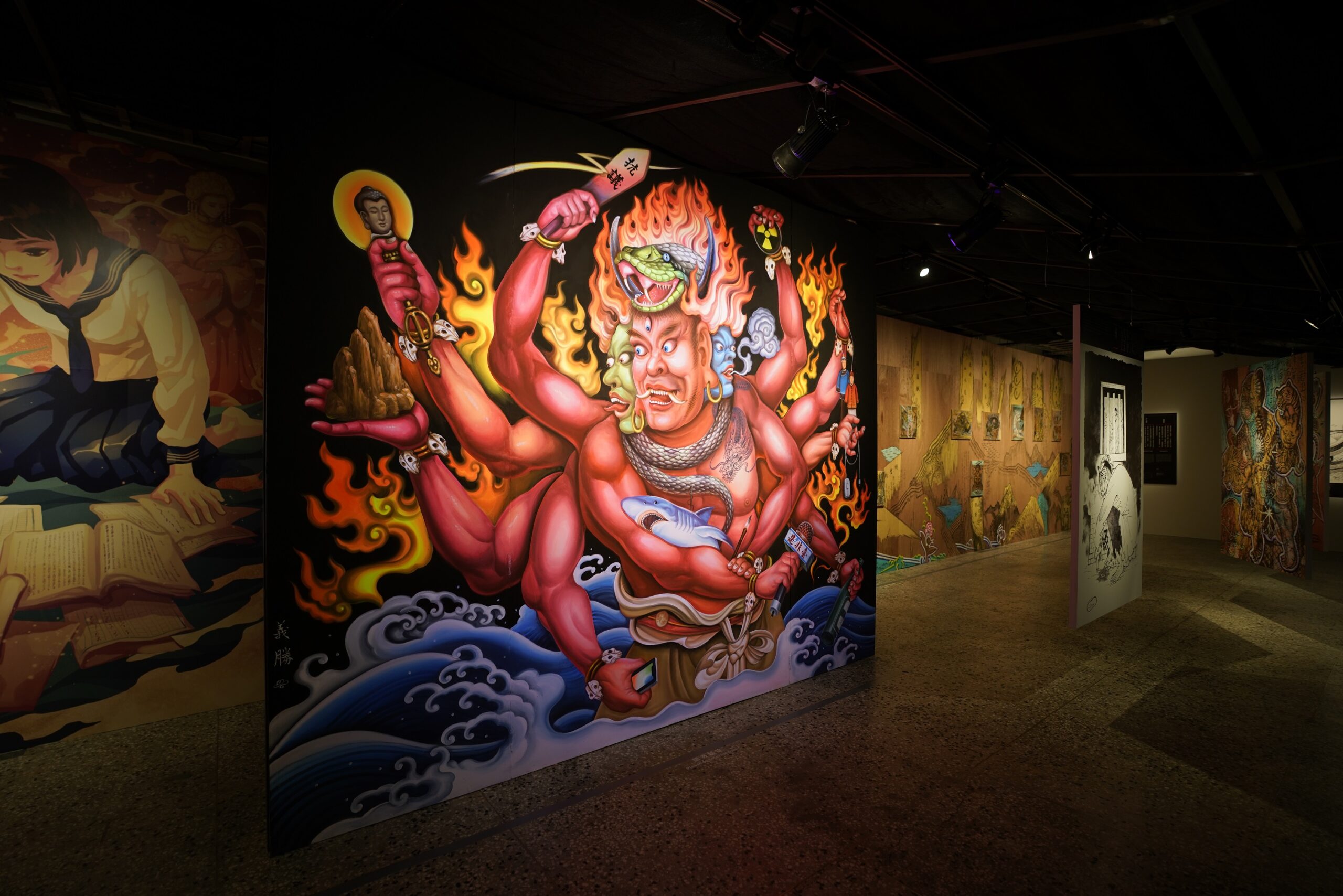 陳冠良畫師的《觸怒天神》中的「我們」,分裂為十隻觸手,呈現「我們」處於無法整合環境與認同分裂的當代世界。圖/周史賓攝影
陳冠良畫師的《觸怒天神》中的「我們」,分裂為十隻觸手,呈現「我們」處於無法整合環境與認同分裂的當代世界。圖/周史賓攝影
這次邀請冠良師的《觸怒天神》參展,使我重新接觸到了這些古老明王諸天、羅漢、太陽、龍王的變相,阿修羅、地獄眾生、幽魂滯魄、無主無依諸鬼神眾,不禁受到震懾。只能讚嘆!更有甚者,如何將當代眾生的生存環境問題代入,便成了我們討論的重點。最後,冠良師把核能、媒體、手機、電腦、老齡化、土地、新興宗教、社會運動、上癮、海洋資源等等符號,置入了《觸怒天神》的十隻觸手上,並以螢光油漆塗料,呼應臺灣民間佈景畫的特有表現形式。
值得比較的另一個特異點,就是《觸怒天神》是一幅三摺畫。與五百年前西方的耶羅尼米斯.波希(Hieronymus Bosch, 1452-1516)的三摺畫《塵世樂園》(The Garden of Earthly Delights)相較之下,《觸怒天神》中的宇宙觀與其所源生的佛道神鬼傳統,竟有呼應之處,那是一個民間宗教尚未理性化、現代化、一元化的人鬼並生的宇宙觀世界,這樣的世界觀所具有的民間信仰的「世界性」,指向了一個不以人類為世界中心的世界觀,人、動物、植物、神、鬼、戰爭、生態並呈在一個尚未為理性化、啟蒙思潮所斷裂的混雜世界中,民間信仰的智慧、巫覡的生態觀,不斷警告人類貪慾所造成的災難。誠如提倡「人類世」反思的思想家布魯諾.拉圖(Bruno Latour)所謂的「我們從未現代過」,冠良師《觸怒天神》中的「我們」,分裂為十隻觸手,呈現「我們」處於無法整合環境與認同分裂的當代世界,這或許正是以妖鬼世界觀進行當代反思的出發點,妖鬼文學之思,正是在破碎的自然與人文環境中,探索文化實驗的未來圖書館,尋找嶄新多元的身分認同與行動網絡。